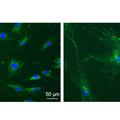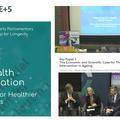Cox Lab of Ageing and Cell Senescence
My lab studies the basic biology underpinning ageing and age-related diseases. We aim to use that knowledge to improve the health of older people through development of new interventions and treatments to promote healthy ageing by treating age-related diseases at cause.
Using a combination of model systems, we look at genes and biochemical pathways that influence health outcomes in ageing, with a particular focus on the process of cellular senescence. Our work aims to define molecular and genetic pathways that govern cell senescence and that underlie organismal ageing and frailty. We are following up our pathway discovery with targeted intervention using pharmacological agents to delay or inhibit senescence, or even reverse detrimental phenotypes.
Who we are and what we do
Current lab members
Lynne Cox (PI)
Christopher Whiteman (DPhil student with Public Health England)
Thibault Teissier (BIRAX/Diabetes UK postdoctoral scientist)
Ivan Boubriak (UK SPINE postdoctoral scientist)
Loren Kell (Mellon Longevity Science Programme DPhil student)
Hamza Ahmad (Mellon Longevity Science Programme DPhil student)
Thomas Goedert (DPhil student)
Sidney Anderl (Part II research project student)
Recent lab members
Adam Rolt (now senior scientist at Medicines Discovery Catapult, UK)
Hannah Walters (Humboldt post-doctoral fellowship, Dresden, Germany)
Sebastian A Brunemeier (LongBio, drug discovery on ageing)
Hayley Lees (Clinical Geneticist, NHS)
Stephanie Gover (Medical School)
Lukeriya Zharova (DPhil student, London)
Strategy papers, evidence and policy:
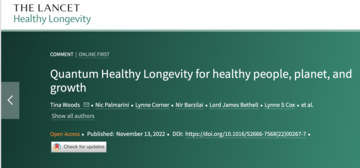
-
Quantum Healthy Longevity for healthy people, planet, and growth (2022) Tina Woods, Nic Palmarini, Lynne Corner, Nir Barzilai, Lord James Bethell, Lynne S Cox, Harris Eyre, Luigi Ferrucci, Linda Fried, David Furman, Brian Kennedy, Andrew Roddam, Andrew Scott, Richard C Siow. The Lancet Healthy Longevity Published:November 13, 2022 DOI:https://doi.org/10.1016/S2666-7568(22)00267-7
- Linking interdisciplinary and multiscale approaches to improve healthspan—a new UK model for collaborative research networks in ageing biology and clinical translation (2022). Lynne S Cox and Richard G A Faragher. The Lancet Healthy Longevity, Volume 3, issue 5, E318-E320, May 01, 2022 DOI: https://doi.org/10.1016/S2666-7568(22)00095-2
- Live Longer or Healthier? The Science That Is Making Both Possible. (2021) – advisor to The Tony Blair Institute of Global Change https://institute.global/policy/live-longer-or-healthier-science-making-both-possible
- Tackling immunosenescence to improve COVID-19 outcomes and vaccine response in older adults (2020). Lynne S Cox, Ilaria Bellantuono, Janet M Lord, Elizabeth Sapey, Joan B Mannick, Linda Partridge, Adam L Gordon, Claire J Steves, Miles D Witham. The Lancet Healthy Longevity | VOLUME 1, ISSUE 2, E55-E57, NOVEMBER 01, 2020, DOI: https://www.thelancet.com/journals/lanhl/article/PIIS2666-7568(20)30011-8/fulltext
- "Health of the Nation: a Strategy for Healthier Longer Lives" report of the All Party Parliamentary Group for Longevity, launched 12th February 2020 Key chapter I (Lynne Cox): 'The Economic and Scientific Case for Therapeutic Intervention in Ageing' (https://appg-longevity.org/events-publications)
- Expert witness: House of Lords select committee Science and Technology Committee (Ageing: Science, Technology and Healthy Living):
- written evidence:http://data.parliament.uk/writtenevidence/committeeevidence.svc/evidencedocument/science-and-technology-committee-lords/ageing-science-technology-and-healthy-living/written/105595.html
- oral evidence: https://parliamentlive.tv/Event/Index/1c0e8f76-2e8a-4e27-a297-4b4f2e9cb5f3
- final report: https://publications.parliament.uk/pa/ld5801/ldselect/ldsctech/183/183.pdf
- Written and oral evidence to The Nuffield Council of Bioethics in-depth inquiry into: The future of ageing. https://www.nuffieldbioethics.org/publications/the-future-of-ageing

"Health of the Nation: a Strategy for Healthier Longer Lives" report of the All Party Parliamentary Group for Longevity
launched 12th February 2020 with Rt Hon Matt Hancock, Secretary of State for Health and Social Care
see Key chapter I - Lynne Cox: 'The Economic and Scientific Case for Therapeutic Intervention in Ageing' (https://appg-longevity.org/events-publications)
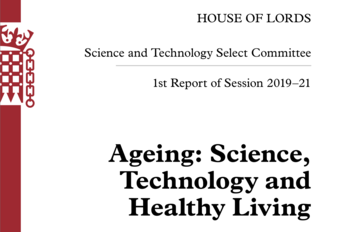
The House of Lords Science and Technology Select Committee published on 15th January 2021 its in-depth report on 'Ageing: Science, Technology and Healthy Living' which makes very specific recommendations to the UK Government.
The following key findings are taken directly from the press release accompanying the report. I quote:
- New Science has potential to improve healthy ageing benefiting the individual, the NHS and society
- UK is global leader in drug development and new technologies with promising advances
- However, Government is missing its key healthy ageing targets and must act now
- Inequalities in healthy life expectancy are stark; COVID-19 has highlighted concerns
- Evidence that the rate of multi-morbidity is increasing; designated clinicians required
I provided both oral and written evidence to the committee which they refer to extensively in the report – a link to the report can be found here:
Further information from the House of Lords website about the enquiry is here.

Science Question Time on "Designing research to serve ageing populations" sponsored by MSD. The report (published 24th February 2021 and available here) highlights the importance of biomedical research in ageing, together with the need to include older people in clinical trials of therapies that will be of benefit to them.
Quote from the report:
"The COVID-19 pandemic has created unprecedented strain on health systems and societies around the world. It has shone a light on health inequalities and reinforced the importance of fostering health resilience. It has also highlighted the importance of scientific research to protect the health and wealth of societies. Science Question Time held on 25 November 2020 brought together leading scientists and policymakers to reflect upon these factors and think about the broader implications for R&D, asking the key question: ‘How can we design research to serve ageing populations and those with comorbidities, and ensure that research is reflecting our societal aim of achieving healthy longevity?’"
We are delighted to announce the launch of the Mission on Quantum Healthy Longevity for healthy people, planet, and growth on 14th November 2022 during Longevity Week
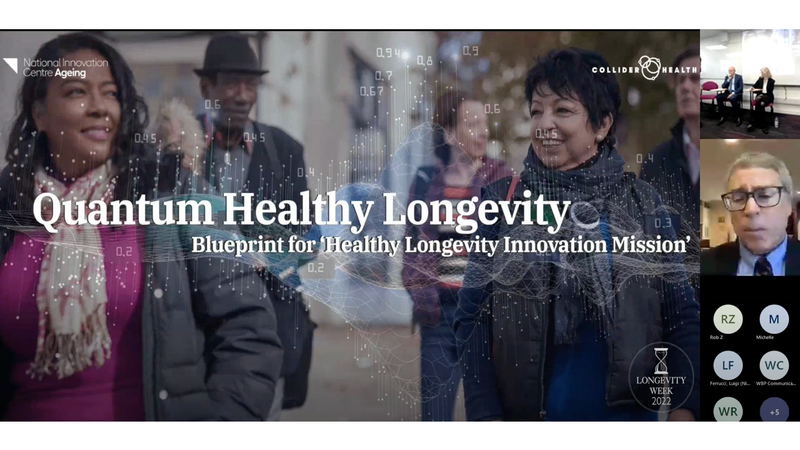
We launched Health of the Nation: a Strategy for Healthier Longer Lives on 12th February, with the Secretary of State for Health and Social Care, the Right Honourable Matt Hancock
see: https://www.youtube.com/watch?time_continue=5&v=tl7lJ1bj2lw&feature=emb_logo
Link to the published strategy report: https://appg-longevity.org/events-publications

This strategy paper was the culmination of many months of work with the All-Party Pparliamentary Group (APPG) for Longevity, on which Lynne Cox serves on both the Strategic Advisory Board and the Science, Genomics and Technology board : https://appg-longevity.org
Lynne also gave evidence to the House of Lords Science and Technology Select Committee on Ageing: Science, Technology and Healthy Living:
•Parliament TV (live recording of the hearing)
•https://parliamentlive.tv/Event/Index/1c0e8f76-2e8a-4e27-a297-4b4f2e9cb5f3 (session 2, starting at 11:27:40)
•Written evidence
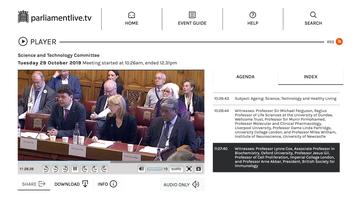
Biochemistry Society Clinical and Translational Science Theme: https://biochemistry.org/events-and-training/theme-panels/clinical-and-translational-research/
Trustee: British Society for Research on Ageing: https://bsra.org.uk
New Hallmarks of ageing - University of Copenhagen Centre for Healthy Ageing

22nd March 2022 in person and online
https://healthyaging.ku.dk/calendar/nnf-hallmarks-of-aging
Royal Society of Medicine - a day on ageing
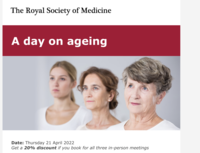
3 symposia all on Thursday 21 Apr 2022 with 20% discount for attendance at all 3 - ion person and livestream online:
https://www.rsm.ac.uk/events/geriatrics-and-gerontology/2021-22/ggq01/
International Cell Senescence Association

Friday, April 29, 2022, 9:30 AM - 5:30 PM London - in person
https://www.qmul.ac.uk/blizard/about/events/items/yicsa-senescence-sympo...
Wellcome Healthy Ageing 2022

25–27 May 2022 online
https://coursesandconferences.wellcomeconnectingscience.org/event/health...
UPCOMING: Ageing Biology subgroup of the European Geriatric Medicine Society (EuGMS) of which I am co-chair, will be launching at the forthcoming EuGMS 2020 E-Congress (https://eugms2020.online/) Wednesday Oct 7th , from 12.00 to 13.30 CEST.

24th September: Biochemical Society webinar: chairing the talk by Prof Alex Breeze, University of Leeds on "The biopharma drug development pathway: origins and comparison with small moelcule delivery"

Over the lockdown period and the summer of 2020, Lynne has given a number of online presenations including:
Oriel online (September 2020): How biomedical sceicens are central to tackling COVID- the role of Orielenses. In coversation with Prof Max Crispin, University of Southampton.
Clare College Cambridge digital gala week speaker June 2020
Oxford Healthy Ageing seminar series speaker 23rd June 2020: How to age well: lessons from geroscience
CogX speaker 9th June 2020
Longevity Leaders 2020 speaker 22nd May 2020: recorded panel discussion: Avoiding hype in ageing science
Also live session: Trends in Ageing Science
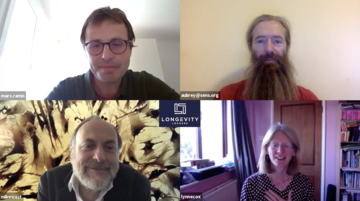
APPG for Longevity Roundtable 4 panellist 19th May 2020: a business index for health
Longevity Technology: Longevity week speaker 26th April 2020: Defining ageing

Oxford Business Network - virtual presentation at Babraham, Cambridge: How to age well: the potential of new drugs to improve health in later life
Schools Science Question Time: virtual presenation at Wimbledon College, London: Can we and should we interfere with the biology of ageing?
#OSEF2020: Oxford Said Entrepreneurship Forum: speaker at the Said Business Schools' annual flagship event, discussing "immortality"

Please note the planned Ageing Science seminar series for Trinity Term 2020 (https://www.archub.ox.ac.uk/2020/03/13/trinity-2020-seminar-series-pre-announcement/) has been postponed because of COVID-19. We hope to be able to run this exciting series of seminars by global leaders in the science of ageing in the future.
Healthy Ageing: From molecules to organisms: POSTPONED DUE TO COVID-19
27 - 29 May 2020 Wellcome Genome Campus, UK
The third conference in this series will focus on recent discoveries and current challenges in ageing research, with a focus on translating basic research insights into health improvement for older people.
Ageing can lead to declining health and function, and it is the major risk factor for cancer, neurodegenerative and cardiovascular disease. We aim to explore the mechanisms of ageing in cells, tissues and organisms in order to identify interventions that can ameliorate its negative effects.
The conference will focus on how recent developments in cell- and immune-senescence, neuroinflammation, stem cells and epigenetics are leading to an increased understanding of the ageing process. This year’s meeting will also highlight research into the ageing brain and nervous system and discuss lifestyle interventions for health improvement.
The meeting is aimed at scientists, clinicians and drug developers involved in research into ageing and other relevant fields.
https://coursesandconferences.wellcomegenomecampus.org/our-events/health...
What causes age-related disease and can ageing be treated?
Ageing and age-related diseases affect some people much more than others: there is no one fixed way to age and everyone is different. While we know that a good diet, exercise and plenty of sleep are important to maintain health, other factors out of our control (e.g. genes, environment) can lead to significant ill health and disability in later life. The vast majority of older people suffer from several chronic age-related diseases simultaneously - this is termed co-morbidity.
We now know that changes to cells as they age, termed cell senescence, can be critical in causing many different diseases of ageing. Exciting new research from labs around the world has shown that removing senescent cells can improve health in later life, and even extend lifespan in mice.
Cells undergo senescence in several different ways in response to DNA damage, activation of oncogenes or simply after they have undergone a large number of cell divisions until their telomeres (repetitive DNA structures at the ends of the chromosomes that shorten at every cell division cycle) have become critically short. Senescence is an important tumour suppressor mechanism to prevent damaged cells from dividing, but the many changes cells undergo as they become senescent leads to them altering their local environment, including degrading tissue structure and promoting a pro-inflammatory and pro-cancer environment.
By identifying the biochemical pathways and specific molecules involved, we aim to develop ways of altering the rate or outcomes of cell senescence, in order to better treat age-associated diseases and frailty.
Talks, videos and podcasts:
- Sky Big Ideas Live (Nov 2022): https://www.youtube.com/watch?v=i1NNWQHJvlQ
- BIRAX conference Nov 2021: https://www.youtube.com/watch?v=aHLdHPYwQiY&list=PLNiWLB_wsOg4tMIjY_rIa1...
- Foresight Institute talk with Brian Kennedy and Joris Deelen. Watch all three talks at: https://www.youtube.com/watch?v=VbWvH1qgcSs
- International Longevity Policy and Governance 2021- my talk starts at 43:32 in : https://www.youtube.com/watch?v=xC2VivaPbp0&t=14s
- UK SPINE: "From bench to care home in a time of COVID": https://www.youtube.com/watch?v=h2G-WX4xm98
- Clare College digital gala June 2020 - How to age well and restore health resilience: https://www.youtube.com/watch?v=F6SzsTcwLWE&feature=emb_logo
- APPG for Longevity launch 12th February 2020: https://www.youtube.com/watch?time_continue=3&v=tl7lJ1bj2lw&feature=emb_logo
- Commentary on launch of APPG for Longevity February 2020: https://www.youtube.com/watch?v=62drmhKulvA&feature=emb_logo
- Longevity Forum panel Nov 2019: How can the UK add five years of healthy lifespan by 2030? https://www.youtube.com/watch?time_continue=4&v=PKXG5Z4VPYw&feature=emb_logo
- House of Lords select committee Science and Technology Committee 29th October 2019 (Ageing: Science, Technology and Healthy Living): https://parliamentlive.tv/Event/Index/1c0e8f76-2e8a-4e27-a297-4b4f2e9cb5f3
- Longevity Leaders #Ageing Science: https://www.youtube.com/watch?v=owi5u5t3Moo
- APPG launch at the House of Commons May 2019 https://www.youtube.com/watch?time_continue=1&v=vrhJdCkoG88
- Telomerase (Royal Institution): http://www.youtube.com/watch?v=bB_sS15o9Do
- Oxford debate: a cure for ageing? http://www.youtube.com/watch?v=uUcA9J3bEcM
- Human ageing gene (WRN) found in flies (BBSRC): http://www.youtube.com/watch?v=IGQwz2Wv9FU
Audio:
- Longevity Forum (14th November 2019): https://thelongevityforum.com/2020/01/16/podcast-with-lynne-cox-the-longevity-forum-2019/
- ABC The Science Show: http://www.abc.net.au/rn/scienceshow/stories/2010/3027370.htm
- Oxford ageing workshop, Said Business School: http://rss.oucs.ox.ac.uk/oxitems/generatersstwo2.php?channel_name=manstud/entrepreneurship-audio (Feb 2010, location -49.31)
BIRAX conference November 2021
As well as diseases traditionally associated with ageing, we are also looking at Type 1 diabetes as a model of premature ageing, studying whether cell senescence contributes to bone fragility and morbidity in diabetes. This is part of a collaboration under the BIRAX/British Council scheme with Prof Rivka Dresner-Pollak in Jerusalem, and funded by Diabetes UK. Here you can see the talk I gave at the latest BIRAX meeting on our progress (forgive the remote broadcasting issues with slide size) :
Longevity Forum Science Summit at Oriel College Oxford, 16th November 2021.
I was delighted to co-host this with Jim Mellon.
We were fortunate to hear from many eminent speakers and colleagues about recent advances in ageing science. Longevity Technology report back from the meeting - see:
Foresight Institute talk with Brian Kennedy and Joris Deelen, where I outline our ideas on the need for polypharmacology and systems biology thinking to address the complexity of ageing. Watch all three talks at: https://www.youtube.com/watch?v=VbWvH1qgcSs
International Longevity Policy and Governance - Lynne presented the case for biomedical longevity sciences helping in the fight against COVID

starts at 43:32 in : https://www.youtube.com/watch?v=xC2VivaPbp0&t=14s
UK SPINE conference: COVID-19 continues to impose a devastating burden on the global population, with older people most at risk of severe disease and death. It is vital that lessons from ageing biology are taken into account when designing new treatments and prophylaxis strategies, and that older people are included in clinical trials. See how basic research can lead to clinical trials in people:

"From bench to care home in a time of COVID"
https://www.youtube.com/watch?v=h2G-WX4xm98
Longevity Forum panel: How can the UK add five years of healthy lifespan by 2030?
https://www.youtube.com/watch?time_continue=4&v=PKXG5Z4VPYw&feature=emb_logo
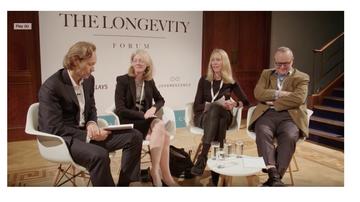
Longevity Leaders #Ageing Science : Lynne is a Trend Host setting out where the field of biogerontology is moving - watch: https://www.youtube.com/watch?v=owi5u5t3Moo
Longevity Forum and The Big Middle podcast :

listen here:
https://podcasts.apple.com/gb/podcast/prof-lynne-cox/id1435522193?i=1000468245260
Research publications: (for further information on publications, awards, positions held etc, see https://orcid.org/0000-0002-5306-285X)
- Lynne S Cox (2022) Therapeutic approaches to treat and prevent age-related diseases through understanding the underlying biological drivers of ageing. The Journal of the Economics of Ageing
2022-10 | Journal article DOI: 10.1016/j.jeoa.2022.100423
-
Schmauck-Medina T, Molière A, Lautrup S, Zhang J, Chlopicki S, Madsen HB, Cao S, Soendenbroe C, Mansell E, Vestergaard MB, Li Z, Shiloh Y, Opresko PL, Egly JM, Kirkwood T, Verdin E, Bohr VA, Cox LS, Stevnsner T, Rasmussen LJ, Fang EF. (2022) New hallmarks of ageing: a 2022 Copenhagen ageing meeting summary. Aging (Albany NY). 2022 Aug 29;14(16):6829-6839. doi: 10.18632/aging.204248
- Thibault Teissier, Vlasdislav Temkin, Rivka Dresner Pollak and Lynne S. Cox (2022). Crosstalk Between Senescent Bone Cells and the Bone Tissue Microenvironment Influences Bone Fragility During Chronological Age and in Diabetes. Front. Physiol., 21 March 2022 https://doi.org/10.3389/fphys.2022.812157
- Teissier T, Boulanger E and Cox LS (2022) Interconnections between inflammageing and immunosenescence during ageing. Cells 2022 11(3) 359; https://doi.org/10.3390/cells11030359https://www.preprints.org/manuscript/202110.0046/v1
- Lynne S Cox and Janet M Lord (2021) Coronavirus: Targeting aging cells improves survival. Science 16 Jul 2021: Vol. 373, Issue 6552, pp. 281-282 DOI: 10.1126/science.abi4474 https://science.sciencemag.org/content/373/6552/281.summary
- Walters, H and Cox, LS (2021) Intercellular transfer of mitochondria between senescent cells through cytoskeleton-supported intercellular bridges requires mTOR and Cdc42 signalling. Oxid Med and Cellular Longevity Vol 2021 Article ID 6697861, https://doi.org/10.1155/2021/6697861
- Rolt, AC and Cox, LS (2020) Structural basis of the anti-ageing effects of polyphenolics - mitigation of oxidative stress. BMC Chemistry volume 14, Article number: 50 (2020)
- Cox, LS. (2020) The Economic and Scientific Case for Therapeutic Intervention in Ageing. Key paper I (p72-80) in "Health of the Nation: a Strategy for Healthier Longer Lives", report of the APPG for Longevity, launched 12th February 2020, https://appg-longevity.org/events-publications
- Cox, L and Goljanek-Whysall, K (2019) Ageing here and now: current research and transformative therapies. Biogerontology 20: 249. https://doi.org/10.1007/s10522-019-09814-5
- Rolt, ACR, Nair, A and Cox, LS (2019) Optimisation of a screening platform for determining IL-6 associated inflammatory signalling in the senescence-associated secretory phenotype (SASP). Biogerontology https://doi.org/10.1007/s10522-019-09796-4
- Walters, HA and Cox, LS (2019) Generation of a novel model of primary human cell senescence through Tenovin-6 mediated inhibition of sirtuins. Biogerontology https://doi.org/10.1007/s10522-018-09792-0
- Walters, HW and Cox, LS (2018) mTORC Inhibitors as Broad-Spectrum Therapeutics for Age-Related Diseases Int J Mol Sci. 2018 Aug 8;19(8). pii: E2325. doi: 10.3390/ijms19082325.
- Chennuri, P, Cox, LS and Saunders, RDC. (2018) EXD2 and WRN exonucleases are required for interstrand crosslink repair in Drosophila. Preprint doi: https://doi.org/10.1101/284307
- Cox, LS, Mason PA. (2018) Towards understanding the biological drivers of cell ageing. Chapter 8 in The New Dynamics of ageing, volume 2. Ed Walker, A. Policy Press (Bristol) ISBN 978-1-4473-1479-0.
- Latorre E, Birar VC, Sheerin AN, Jeynes JCC, Hooper A, Dawe HR, Melzer D, Cox LS, Faragher RGA, Ostler EL, Harries LW. (2017) Small molecule modulation of splicing factor expression is associated with rescue from cellular senescence. BMC Cell Biol. 2017 Oct 17;18(1):31. doi: 10.1186/s12860-017-0147-7.
- Cox, LS and Redman C. (2017) The role of cellular senescence in ageing of the placenta Placenta. 2017 Apr;52:139-145. doi: 10.1016/j.placenta.2017.01.116. Epub 2017.
- Lees H, Walters H, Cox LS. (2016) Animal and human models to understand ageing. Maturitas. 2016 Nov;93:18-27. doi: 10.1016/j.maturitas.2016.06.008.
- Alimbetov D, Davis T, Brook AJ, Cox LS, Faragher RG, Nurgozhin T, Zhumadilov Z, Kipling D. (2016) Suppression of the senescence-associated secretory phenotype (SASP) in human fibroblasts using small molecule inhibitors of p38 MAP kinase and MK2. Biogerontology. 2016 Apr;17(2):305-15. doi: 10.1007/s10522-015-9610-z.
- Walters HE, Deneka-Hannemann S, Cox LS. (2016) Reversal of phenotypes of cellular senescence by pan-mTOR inhibition. Aging (Albany NY). 2016 Feb;8(2):231-44.
- Alimbetov D, Davis T, Brook AJ, Cox LS, Faragher RG, Nurgozhin T, Zhumadilov Z, Kipling D (2016) Suppression of the senescence-associated secretory phenotype (SASP) in human fibroblasts using small molecule inhibitors of p38 MAP kinase and MK2. Biogerontology. 2016 Apr;17(2):305-15
- Cox LS (2015) The fast-mimicking diet - a new approach to treating obesity and diabetes? The Digest (journal for the Primary Care Society of Gastroenterology) Autumn/Winter 2015
- Cox LS (2015) PCNA tightens its hold on the nucleus. Cell Cycle 14(17):2727-8.
- Cox, LS, Mason, PA, Bagley, MC, Steinsaltz, D, Stefanovska, A, Bernjak, A, McClintock, PVE, Phillips, AC, Upton, J, Latimer, JE, Davis, T. (2014) Understanding ageing: biological and social perspectives. Chapter 2 p25-76 in ‘The New Science of Ageing” ed Walker, A. Policy Press (Bristol). ISBN 13: 9781447314677
- Mason, PA, Boubriak, I and Cox, LS (2013) A fluorescence-based exonuclease assay to characterise DmWRNexo, orthologue of human progeroid WRN exonuclease, and its application to other nucleases. J Vis Exp. 2013 Dec 23;(82):e50722. doi: 10.3791/50722.
- Cox, L. S. and Mason, P. A. (2013) The role of WRN helicase/exonuclease in DNA replication. Chapter 9 in The Mechanisms of DNA Replication, ed. D Stuart. In Tech publishing. DOI: 10.5772/51520
- Kenessary, A. Zhumadilov, Z, Nurgozhin, T, Kipling, D, Yeoman, M, Cox, L, Ostler, E. and Faragher, F. (2013) Biomarkers, interventions and healthy ageing. N Biotechnol. 2013 May 25;30(4):373-7.
- Mason PA, Boubriak I, Robbins T, Saunders RDC and Cox LS (2013) DmWRNexo processes replication fork and bubble substrates but is inhibited by the presence of uracil or abasic sites. Age (Dordr). 2013 Jun;35(3):793-806.
- Mason, PA and Cox, LS (2012) The role of DNA exonucleases in protecting genome stability and their impact on ageing. AGE (Dordr). 2012 Dec;34(6):1317-40.
- Bird, JLE, Jennert-Burston, KCB, Bachler, MA, Lowe, JE, Heo, S-J, Campisi, J, Faragher, RGA, Cox, LS (2012) Recapitulation of Werner syndrome sensitivity to camptothecin by limited knockdown of the WRN helicase/exonuclease. Biogerontology 13 (1) 49-62
- Cox, LS and Boubriak I (2011) DNA instability in premature ageing. In: Encyclopedia of DNA Research, Nova Science Publishers Chapter 14 ISBN 987-1-61324-305-3
- Mason, PA and Cox, LS (2010) Prospects for rejuvenation of aged tissue by telomerase reactivation. Rejuvenation Research 13, 749-754
- Cox, LS (2009) Live fast, die young: new lessons in mammalian longevity. Rejuvenation Res. 12(4): 283-288.
- Cox, LS and Mattison, JA (2009) Increasing longevity through caloric restriction or rapamycin feeding in mammals: common mechanisms for common outcomes? Aging Cell. 8(5): 607-13
- Boubriak I, Mason PA, Clancy DJ, Dockray J, Saunders RD, Cox LS. (2009) DmWRNexo is a 3'-5' exonuclease: phenotypic and biochemical characterization of mutants of the Drosophila orthologue of human WRN exonuclease. Biogerontology. 2009 Jun;10(3):267-77.
- Cox, L.S. Cell senescence: the future of ageing?. Biogerontology 10, 229–233 (2009). https://doi.org/10.1007/s10522-008-9207-x
- Saunders RD, Boubriak I, Clancy DJ, Cox LS. (2008) Identification and characterization of a Drosophila ortholog of WRN exonuclease that is required to maintain genome integrity. Aging Cell. 2008 Jun;7(3):418-25.
- Cox LS, Clancy DJ, Boubriak I, Saunders RD. (2007) Modeling Werner Syndrome in Drosophila melanogaster: hyper-recombination in flies lacking WRN-like exonuclease. Ann N Y Acad Sci. 2007 Nov;1119:274-88.
- Cox LS, Faragher RG. (2007) From old organisms to new molecules: integrative biology and therapeutic targets in accelerated human ageing. Cell Mol Life Sci. 2007 Oct;64(19-20):2620-41.
- Rodriguez-Lopez AM, Whitby MC, Borer CM, Bachler MA, Cox LS. (2007) Correction of proliferation and drug sensitivity defects in the progeroid Werner's Syndrome by Holliday junction resolution. Rejuvenation Res. 2007 Mar;10(1):27-40. PubMed PMID: 17378750.
- Riva, F., Savio, M., Cazzalini, O., Stivala, L. A., Scovassi, I. A., Cox, L. S., Ducommun, B. and Prosperi, E. (2004) Distinct pools of proliferating cell nuclear antigen associated to DNA replication sites interact with the p125 subunit of DNA polymerase d or DNA ligase I. Experimental Cell Research 293 357– 367
- Rodríguez-López, A.M., Jackson, D.A., Nehlin, J. O., Iborra, F., Warren, A. V. and Cox, L. S. (2003) Characterisation of the interaction between WRN, the helicase/exonuclease defective in progeroid Werner’s syndrome, and an essential replication factor, PCNA. Mech. Ag. Dev 124, 167-174
- Rodríguez-López, A.M., Jackson, D.A., Iborra, F., and Cox, L.S. (2002) Asymmetry of DNA replication fork progression in Werner’s syndrome. Ageing Cell 1, 30-39
- Ji-Liang Li, Anna V Warren, Lynne S Cox (2002) Identification of a second proliferating cell nuclear antigen in the human malarial pathogen Plasmodium falciparum. International Journal for Parasitology, Vol 32, Issue 14, 1683-1692, ISSN 0020-7519 https://doi.org/10.1016/S0020-7519(02)00162-5.
- Li JL, Cox LS. (2001) Identification of an MCM4 homologue expressed specifically in the sexual stage of Plasmodium falciparum. Int J Parasitol. 2001 Sep;31(11):1246-52. doi: 10.1016/s0020-7519(01)00237-5
- Li J, Cox LS. (2000) Isolation and characterisation of a cAMP-dependent protein kinase catalytic subunit gene from Plasmodium falciparum. Mol Biochem Parasitol. 2000 Jul;109(2):157-63. doi: 10.1016/s0166-6851(00)00242-5.
- Li JL, Baker DA, Cox LS. (2000) Sexual stage-specific expression of a third calcium-dependent protein kinase from Plasmodium falciparum. Biochim Biophys Acta. 2000 Apr 25;1491(1-3):341-9. doi: 10.1016/s0167-4781(00)00032-4.
- Ongkeko WM, Wang XQ, Siu WY, Lau AW, Yamashita K, Harris AL, Cox LS, Poon RY. (1999) MDM2 and MDMX bind and stabilize the p53-related protein p73. Curr Biol. 9(15):829-32.
- Cox LS. (1997) Multiple pathways control cell growth and transformation: overlapping and independent activities of p53 and p21Cip1/WAF1/Sdi1. J Pathol. 183(2):134-40.
- Cox LS. (1997) Who binds wins: Competition for PCNA rings out cell-cycle changes. Trends Cell Biol. 7(12):493-8.
- Warbrick E, Lane DP, Glover DM, Cox LS. (1997) Homologous regions of Fen1 and p21Cip1 compete for binding to the same site on PCNA: a potential mechanism to co-ordinate DNA replication and repair. Oncogene. 14(19):2313-21.
- Kernohan NM, Cox LS. (1996) Regulation of apoptosis by Bcl-2 and its related proteins: immunochemical challenges and therapeutic implications. J Pathol. 179(1):1-3.
- Frosina G, Fortini P, Rossi O, Carrozzino F, Raspaglio G, Cox LS, Lane DP, Abbondandolo A, Dogliotti E. (1996) Two pathways for base excision repair in mammalian cells. J Biol Chem. 271(16):9573-8.
- Hall PA, Kearsey JM, Coates PJ, Norman DG, Warbrick E, Cox LS. (1995) Characterisation of the interaction between PCNA and Gadd45. Oncogene. 10(12):2427-33.
- Cox LS, Lane DP. (1995) Tumour suppressors, kinases and clamps: how p53 regulates the cell cycle in response to DNA damage. Bioessays. 17(6):501-8.
- Cox LS, Hupp T, Midgley CA, Lane DP (1995). A direct effect of activated human p53 on nuclear DNA replication. EMBO J. 14(9):2099-105.
- Warbrick E, Lane DP, Glover DM, Cox LS. (1995) A small peptide inhibitor of DNA replication defines the site of interaction between the cyclin-dependent kinase inhibitor p21WAF1 and proliferating cell nuclear antigen. Curr Biol. 5(3):275-82.
- Cox LS, Midgley CA, Lane DP. (1994) Xenopus p53 is biochemically similar to the human tumour suppressor protein p53 and is induced upon DNA damage in somatic cells. Oncogene. 9(10):2951-9.
- Hutchison CJ, Bridger JM, Cox LS, Kill IR. (1994) Weaving a pattern from disparate threads: lamin function in nuclear assembly and DNA replication. J Cell Sci. 107:3259-69.
- Cox LS, Hutchison CJ. (1994) Nuclear envelope assembly and disassembly. Subcell Biochem. 22:263-325.
- Cox LS. (1992) DNA replication in cell-free extracts from Xenopus eggs is prevented by disrupting nuclear envelope function. J Cell Sci. 101 :43-53.
- Cox LS, Laskey RA. (1991) DNA replication occurs at discrete sites in pseudonuclei assembled from purified DNA in vitro. Cell. 66(2):271-5.
- Laskey RA, Cox LS, Leno GH, Philpott A, Mills AD, Sleeman AM. (1991) Control of DNA replication in reconstituted nuclei. Cold Spring Harb Symp Quant Biol. 56:347-52.
- Cox LS, Leno GH. (1990) Extracts from eggs and oocytes of Xenopus laevis differ in their capacities for nuclear assembly and DNA replication. J Cell Sci. 97:177-84.
- Dingwall C, Dilworth SM, Black SJ, Kearsey SE, Cox LS, Laskey RA. (1987) Nucleoplasmin cDNA sequence reveals polyglutamic acid tracts and a cluster of sequences homologous to putative nuclear localization signals. EMBO J. 6(1):69-74.
Books:
Cox, LS.(Ed) (2009) Molecular Themes in DNA Replication. Royal Society of Chemistry (Cambridge) ISBN 978-0-85404-164-0 (research text)
Cox, LS, Harris, DA, Pears, CJ. (2012) Thrive in Biochemistry and Molecular Biology. OUP (Oxford). ISBN: 978-0-19-964548-0 (undergraduate teaching/revision text)
Research monograph:
Cox, LS.(Ed) (2009) Molecular Themes in DNA Replication. Royal Society of Chemistry (Cambridge) ISBN 978-0-85404-164-0 (research text)
Undergraduate textbook:
Cox, LS, Harris, DA, Pears, CJ. (2012) Thrive in Biochemistry and Molecular Biology. OUP (Oxford). ISBN: 978-0-19-964548-0 (undergraduate teaching/revision text)
Training materials
- Cox, LS (2022) Molecular biology tools in ageing reserarch. (BLAST ageing summer school; https://canvas.instructure.com/courses/5187555)
- Cox, LS (2022) RNAseq and differential gene expression analysis in ageing studies. (BLAST ageing summer school; https://canvas.instructure.com/courses/5187555)
Oxford Ageing Network - OxAgeN
The Oxford Ageing Network, OxAgeN, welcomes scientists and clinicians from around the Oxford area to meet and discuss latest advances in ageing research.
We are delighted to announce funding for OxAgen from the John Fell fund to support 6 future meetings of the network over the next 2 years.

Please follow the link to the OxAgeN webpage: https://coxlab.web.ox.ac.uk/oxagen
Approaches we take to understand and treat ageing
Cell senescence is a state of cell cycle arrest with cell growth, morphological changes and alteration in gene expression patterns leading to secretion of pro-inflammatory mediators and enzymes that damage tissue structure.
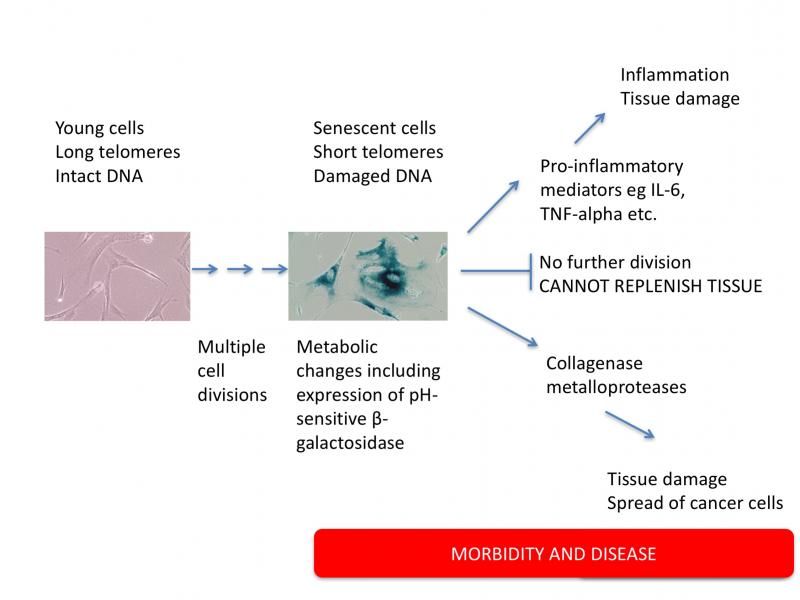
We are also interested in investigating the role of a gene WRN which when mutated in humans leads to the premature ageing Werner’s syndrome. That a single gene can result in the early development of many age-related diseases including atherosclerosis, diabetes, cataracts, osteoporosis and cancer provides very strong evidence that there is a central underlying cause of many of the diseases of later life. Mutation of a closely related gene EXD2 also leads to genome instability and we are interested in the interplay between efficient DNA repair and maintenance of cellular longevity. We are studying the effect of WRN loss and its biochemcial activities in worms, flies and humans.
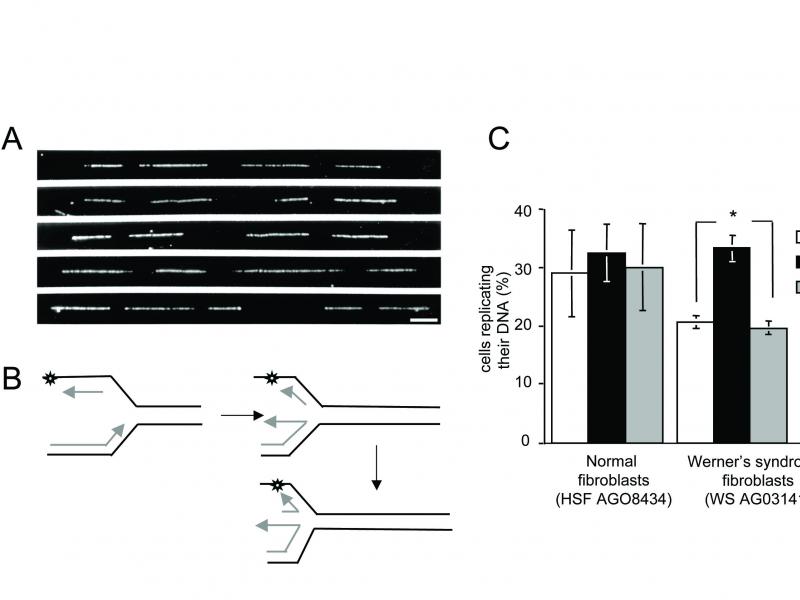
Cell senescence can occur as a result of many different cellular stresses. These can include DNA damage signalling arising from shorted telomeres after many rounds of cell division, more acute forms of DNA damage e.g. after exposure to ionising radiation or UV light, activation of cellular oncogenes, high levels of nutrients which drive cells into a hyper-growth phenotype, hormones (including insulin and insulin-like growth factor) as well as generalised intracellular and extracellular stresses (e.g. high ROS). These feed into key pathways that modulate the cell's response. Our focus is particularly on mTOR as master regulator, WRN as a key DNA damage response protein implicated in ageing, and p53, the tumour suppressor protein that when hyperactive causes ageing.
We are exploiting the power of multiplex proteomics to identify molecular pathways important in senescence.
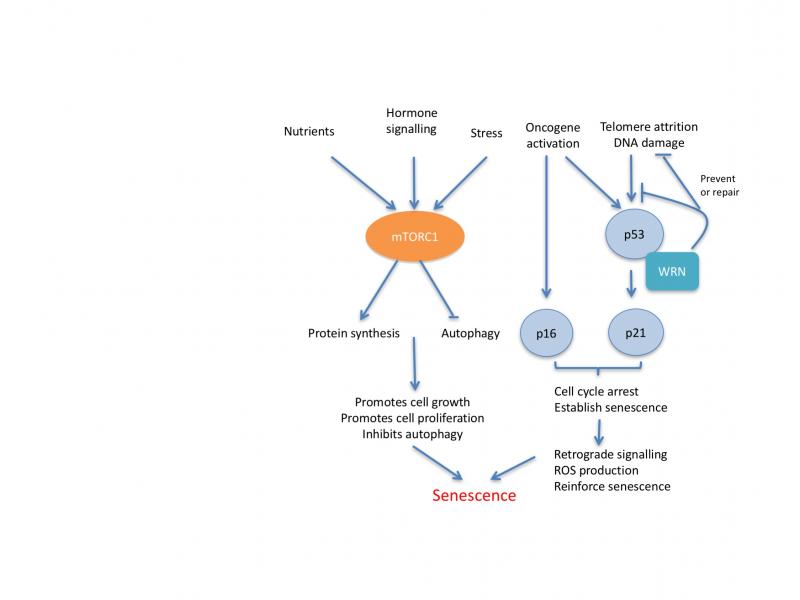
Key molecules involved in driving and maintaining cellular senescence are the tumour suppressor proteins p16 and p53, and the p53-activated cyclin-dependent kinase inhibitor p21, while the mTORC1 kinase and its downstream effectors are antagonistic and promote cell growth and proliferation.
The fruit fly Drosophila allows us to explore how changes in certain age-related genes influence the overall stability of the genome. We have identified a WRN-like exonuclease in flies (Saunders et al 2008 Aging Cell 7 (3) 418-425) and are using this to study the relationship between DNA repair, genome instability and ageing, as well as studying ageing in normal (wild type) flies and those with stem cell defects. Fly work is carried out in collaboration with Dr Robert Saunders of the Open University, together with Prof Petros Ligoxygakis in Oxford.
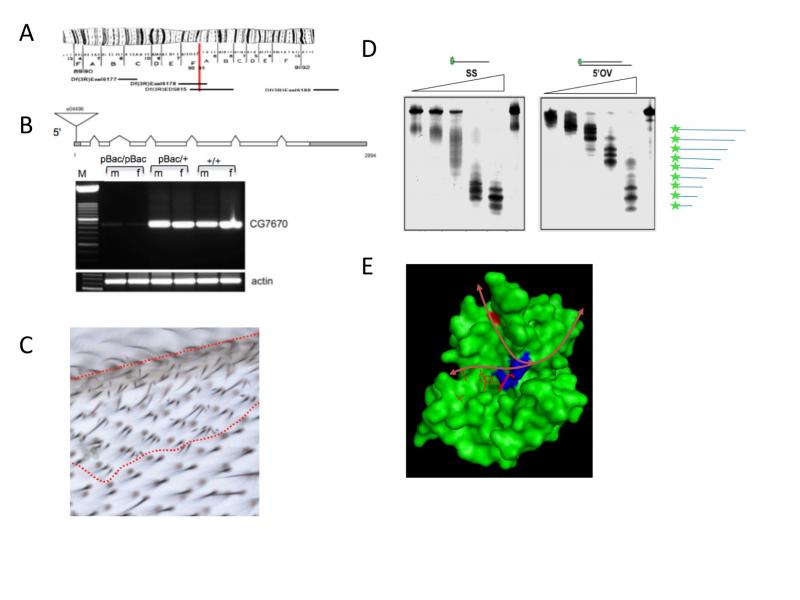
We are taking two approaches towards developing novel senomodifying interventions: target-based against molecules identified as important in our proteomics studies, together with phenotypic screens for correction of senescent phenotypes.
We are actively designing new ways to identify drugs that can modify senescence and hence help to treat or even prevent the diseases of ageing. We have recently optimised a screening platform based on a biosensor that can detect very low levels of pro-inflammatory IL-6.
Teaching and external appointments
I am course organiser for the undergraduate Molecular Biology and Genetics paper. I lecture on DNA replication and tools in molecular biology.
https://weblearn.ox.ac.uk/portal/site/:medsci:bioch:ug:y2:molecular
I am the George Moody fellow and Tutor in Biochemistry at Oriel College, Oxford, where I help to organise and deliver tutorial teaching for the Oriel Biochemists.
I am also resposnible for admisision of undergraduates to read biochemistry at Oriel.
I run practical classes in biochemistry for first year medical students throughout the year.
I also help with CPD training for clincal geronotologists as they approach their MRCP exmainations, giving lectures on the biology of ageing.
Trustee of the British Society for Research on Ageing
Clincial and Translational Theme Panel , the Biochemical Society
https://biochemistry.org/events-and-training/theme-panels/clinical-and-translational-research/
All Party Parliamentary working group (APPG) on Longevity (Houses of Parliament, UK)
Strageic Advisory Board and Science, genomics and technology board
https://appg-longevity.org/advisory-board
NO-Age, The Norwegian Centre on Healthy Ageing
Primary international member
EU Geriatric Medicine Society
Co-chair, special interest group on Ageing Biology
Model systems we use to study ageing:
Human cells cultured in the lab allow us to identify biochemical pathways of senescence and to test drugs directly in human cells with direct relevance to human ageing.
Werner syndrome, a premature ageing disease in humans, is cause by mutation of a single gene WRN. Working out how WRN acts in cells to prevent premature ageing, and how loss of function of just one gene causes multiple diseases of ageing is important in working out how to treat age-related diseases.
The fruit fly Drosophila melanogaster: we have identified the WRN exonuclease gene in flies, and have tested its roles in development, DNA replication, repair and recombination. We have also carried out biochemical analysis of the WRN nuclease activity.
The nematode worm C. elegans allows us to test the effect of genes and/or chemical interventions on whole organism ageing within a very short time frame. Worms share more than 50% of genes with humans and show very similar ageing pathways, including premature ageing when the worm version of WRN (wrn-1) is mutated.
Lab members
Current lab members:
Lynne Cox (PI)
Adam Rolt (Elysium post-doctoral fellow)
Christopher Whiteman (DPhil student with Public Health England)
Thibault Teissier (BIRAX/Diabetes UK postdoctoral scientist)
Ivan Boubriak (UK SPINE postdoctoral scientist)
Loren Kell (Mellon Longevity Science Programme DPhil student)
Kara d'Arcy (Part II research project student)
Recent lab members
Hannah Walters (Humboldt post-doctoral fellowship, Germany)
Sebastian Aguiar (Biotech startup on ageing, USA)
Hayley Lees (Clinical Geneticist, NHS)
Stephanie Gover (Medical School)
Lukeriya Zharova (DPhil student, London)









